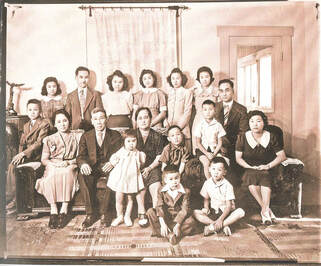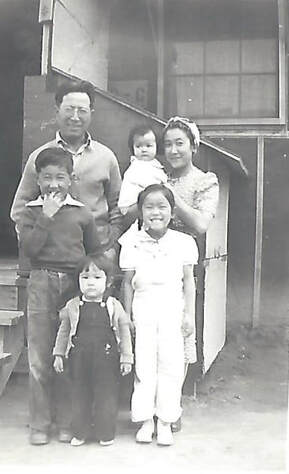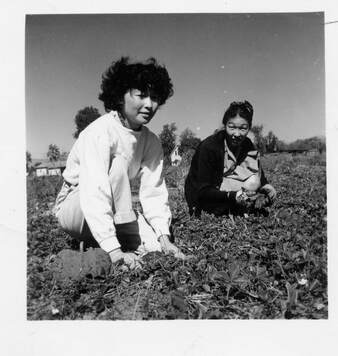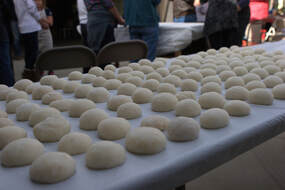the kim and inaba family friendship in detail
 Inaba Family photo, 1940. Mits is front row, white collar, dark outfit.
Inaba Family photo, 1940. Mits is front row, white collar, dark outfit.
Korean and Japanese American Friendship Breaks Racial Barriers
Violet Catherine Kim's family and the Inaba family lived in Riverside, CA since the early 1900s. The unique friendship between the two families would last until Catherine's death in 2018. When the Inaba and Kim friendship began - right before World War II - they broke cultural and ethnic boundaries. Below are details on the Inaba and Kim families and their friendship.
Why was the friendship so unique?
In 1910 Japan officially colonized Korea after years of already interfering in Korean politics. Catherine's grandparents were Korean independence activists. Her grandfather, In Soo Kim, was a Korean National Association member of North America member and helped to operate the first Koreatown, USA in Riverside, CA - Pachappa Camp.
Koreans and Japanese did not get along due to a long history of interethnic strife. Even in America, during the early 1900s, both communities did not like each other. Yet, Catherine Kim and her sister Lucy and Mallie would become friends with the Inaba family, first with Chikayasu and Kiri Inaba and later with their children. Catherine would become close friends with Mitsuru "Mits" Inaba whose wife Meiko would later build a lifelong friendship with Catherine as well.
Catherine was the granddaughter of a Korean American independence activist. In the early 1900s, it was unheard of for a Korean American to become close friends with a Japanese American family. Yet these are the stories that often go untold, lost in the spaces and margins of time and undocumented histories. Such powerful interethnic stories of friendship and bonds, deepen and enrich the history of communities like Riverside, whose legacy is more than just citrus.
The Inaba Family
Mitsuru "Mits" was born in 1935 and raised in Riverside with his six siblings. Mits' father, Chikayasu, was born in Japan in 1901. He and his mother Hanai "Aba" Inaba immigrated to the US in 1918 to join his father Risaburo in Riverside, CA. Risaburo "Oji" Sumiya had been in in the U.S. since 1905 and had purchased farmland in Riverside. (Risaburo took his wife's surname to preserve it and thus he became Risaburo Inaba). Chikayasu went to Japan in 1924 to wed Kiri Kawata. The couple moved back to Riverside, purchased a farm near his parents' land and started their family. Mits was the fifth child of seven to the couple. During World War II The Inaba family were incarcerated at Crystal City and Manzanar. After being released from internment, they moved back to Riverside where they continued their farming. Mits stayed in Riverside after the incarceration and would later fall in love with and marry Meiko Mikami. Mits worked and lived in Riverside till he died in 2012, he is survived by his children, grandchildren, and Meiko. She continues to live in Riverside today.
 Meiko as a young girl, front, right in the white outfit. Date unknown.
Meiko as a young girl, front, right in the white outfit. Date unknown.
Meiko, however, did not grow up in Riverside. Born in Hollywood, CA in 1938, Mieko and her family lived in the city until they were incarcerated in 1942. Meiko had four siblings; she was the second eldest. Mieko's family was incarcerated during World War II at the Heart Mountain Relocation Center; she was five years old. After being released, Meiko's family moved around until they finally came back to California in the late 1940s. She grew up in Gardena, CA. Her father, Satoshi "Mike" Mikami had owned a produce store on Sunset Blvd. in Hollywood before incarceration. After coming back to California, Mike opened a new produce stand in Redondo Beach, CA sometime in 1948 or 1949, according to Meiko. Her mother, Toshie Mildred Shimane was born and raised in Santa Ana and would later also become friends with Catherine Kim.
Meiko went to Pepperdine for one semester and then transferred to UCLA and moved to Westwood in 1956/57. During her time at school, she lived in a commune with 42 other girls of all ethnicities. She graduated in 1960 with a degree in education. During her time in school she met Mits through her roommate who was dating his brother at the time. The whirlwind romance ended up in an elopement, a ceremony in Las Vegas, and a new life for Meiko in 1961.
Meiko moved to Riverside with Mits and at first, didn't have much to do with the Kim family. However, after 18 years at Riverside County as an Assistant Personnel Director, Meiko retired in 1992. A few years into retirement, she started to get to know Catherine better. The two would sit and talk about Catherine's family and life and strong friendship would develop between the two women.
Meiko went to Pepperdine for one semester and then transferred to UCLA and moved to Westwood in 1956/57. During her time at school, she lived in a commune with 42 other girls of all ethnicities. She graduated in 1960 with a degree in education. During her time in school she met Mits through her roommate who was dating his brother at the time. The whirlwind romance ended up in an elopement, a ceremony in Las Vegas, and a new life for Meiko in 1961.
Meiko moved to Riverside with Mits and at first, didn't have much to do with the Kim family. However, after 18 years at Riverside County as an Assistant Personnel Director, Meiko retired in 1992. A few years into retirement, she started to get to know Catherine better. The two would sit and talk about Catherine's family and life and strong friendship would develop between the two women.
 Catherine Kim in the front with one of her sisters. Date uknown.
Catherine Kim in the front with one of her sisters. Date uknown.
Violet Catherine Kim's Family
The Kim family also had deep roots in the Riverside community. Like the Inaba family, Violet Catherine Kim's family were early residents of the citrus town. Violet, who liked to go by the name Catherine, had five siblings. She was the daughter of Yong Ryon Kim and Hazel Han Kim. Yong Ryon's father, In Soo Kim, was living and working in Riverside sometime in 1904/early 1905. He was a labor contractor for the Korean Labor Bureau and a member of the Gongnip Hyophoe, a Korean independence organization. He was a fervent Korean independence activist fighting for the freedom of his homeland from Japanese occupation. Koreans in America during the early 1900s were preoccupied with the independence movement and did not associate with the members of the nearby Japanese settlement. In Soo Kim also helped to run and operate Pachappa Camp, the first Koreatown USA in Riverside, CA which was founded by Dosan Ahn Chang Ho. In fact, Koreans at Pachappa Camp during the early 1900s chose to work with the Chinese American community and even boycotted Japanese products like soy sauce. The divide between the Korean and Japanese community ran deep.
In Soo Kim was a major character in the lives of the Riverside Korean community. His son Yong Ryon would stay in Riverside and farm a five-acre plot he owned. The Kim family also purchased and farmed a 30-acre vineyard in Delano, CA.
Catherine was born on November 22, 1922 in Riverside and attended Polytechnic High School, earned a degree from UCLA, and even worked as a general mechanic helper and junior mechanic in 1942 and 1943 at the March Field Air Base in Riverside. She became a teacher at the Grand Terrace, Terrace View, and Lincoln Schools for the Colton Joint School Districts and retired in 1984.
Catherine became the last surviving child of Yong Ryon and Hazel and would live at their home in Riverside on Streeter Street until she had to move to assisted living. The historic property was sold in 2018 following Catherine's death in April 2018. Her death marked the end of any direct ties in Riverside to Pachappa Camp.
The Kim family also had deep roots in the Riverside community. Like the Inaba family, Violet Catherine Kim's family were early residents of the citrus town. Violet, who liked to go by the name Catherine, had five siblings. She was the daughter of Yong Ryon Kim and Hazel Han Kim. Yong Ryon's father, In Soo Kim, was living and working in Riverside sometime in 1904/early 1905. He was a labor contractor for the Korean Labor Bureau and a member of the Gongnip Hyophoe, a Korean independence organization. He was a fervent Korean independence activist fighting for the freedom of his homeland from Japanese occupation. Koreans in America during the early 1900s were preoccupied with the independence movement and did not associate with the members of the nearby Japanese settlement. In Soo Kim also helped to run and operate Pachappa Camp, the first Koreatown USA in Riverside, CA which was founded by Dosan Ahn Chang Ho. In fact, Koreans at Pachappa Camp during the early 1900s chose to work with the Chinese American community and even boycotted Japanese products like soy sauce. The divide between the Korean and Japanese community ran deep.
In Soo Kim was a major character in the lives of the Riverside Korean community. His son Yong Ryon would stay in Riverside and farm a five-acre plot he owned. The Kim family also purchased and farmed a 30-acre vineyard in Delano, CA.
Catherine was born on November 22, 1922 in Riverside and attended Polytechnic High School, earned a degree from UCLA, and even worked as a general mechanic helper and junior mechanic in 1942 and 1943 at the March Field Air Base in Riverside. She became a teacher at the Grand Terrace, Terrace View, and Lincoln Schools for the Colton Joint School Districts and retired in 1984.
Catherine became the last surviving child of Yong Ryon and Hazel and would live at their home in Riverside on Streeter Street until she had to move to assisted living. The historic property was sold in 2018 following Catherine's death in April 2018. Her death marked the end of any direct ties in Riverside to Pachappa Camp.
 Mochitsuki at Catherine's farm in Riverside on Streeter Street, 2015.
Mochitsuki at Catherine's farm in Riverside on Streeter Street, 2015.
A Lifelong Friendship
The friendship between the Kim and Inaba family began in 1939, right before the start of World War II, and would blossom as the years passed. Despite the deep divide between the Korean and Japanese American communities, Catherine and Chikayasu, his wife and children developed a friendship that stood the test of time and broke the barriers of cultural and ethnic strife.
At the invitation of Chikayasu and Kiri, Catherine and her sisters Mallie and Lucy picked #2 strawberries at the Inaba farm. The Kim's turned the strawberries into jam and other baked goods and give them to the Inabas. The two families maintained their friendship despite the long history of Korean-Japanese interethnic strife. Before World War II, Koreans in Riverside actively worked for the independence of their homeland from Japan. Thus, they did not associate themselves with the Japanese community which also had a settlement in Riverside.
The story of the Kim and the Inaba family friendship has gone untold. The rich, lifelong, generational friendship is an example of how interethnic friendships grew despite geopolitical factors/issues and ethnic barriers.
Mits' family continued their friendship with the Kim's even after incarceration ended. Despite their age differences, Mits and Catherine remained friends even after his father and mother passed away in 1979 and 1984, respectively. Eventually, Mits would start helping Catherine with growing, planting, and plowing the Kim farmlands. Meiko would also become friends with Catherine.
"I never saw Catherine as Korean," Meiko Inaba said in an interview. "In my mind, I never thought we shouldn't be friends because she was Korean."
Meiko and Mits helped Catherine with her farm over the years. However, it wasn't until 1998 that the friendship between Meiko and Catherine grew into a bond that would last the rest of their lives. "That's when I got to really know her," Meiko said. Meiko and Catherine would talk about the Kim family history and about how actor Philip Ahn used to visit Catherine's family. (Catherine's mother was a distant relative of Dosan Ahn Chang Ho, Philip's father). Meiko often helped Catherine with household affairs like bills. "We became her family," Meiko said.
Catherine, who was a bit of a recluse, according to Meiko, opened her farm to the Inaba family for their annual Mochitsuki (pounding rice to make mochi, a soft rice cake). In 2003, Mits and Meiko sold off the last part of their farmland. The couple had hosted Mochitsuki at their farm since the late 1960s. However, after they sold their land, they couldn't accommodate the gathering at their home in Riverside. Thus, the Inaba Mochitusuki tradition continued on the Kim family farm. The last Mochitsuki was held in 2019 and due to the COVID-19 pandemic, there was no event in 2020.
Catherine, Mits, and Meiko remained friends for the rest of their lives. Meiko, who continues to live in Riverside, recalled their friendship as wonderful. Catherine, Meiko said, was a fighter and didn't back down from anything. She was a force to be reckoned with. Mits, whose lifelong career with Cal Trans and his passion for farming, was the love of her life.
Mits passed away in August 2012 and Catherine passed away in April 2018.
The Kim and Inaba family friendship helps to illustrate that the lives and friendships of the early multiethnic communities in Riverside were far more intertwined and beautiful than we know.
Special thank you to Meiko Inaba and her family for sharing this story and the photographs of her family and Violet Catherine Kim. Information and quotes are pulled from documents and interviews of Meiko Inaba and Violet Catherine Kim.
The friendship between the Kim and Inaba family began in 1939, right before the start of World War II, and would blossom as the years passed. Despite the deep divide between the Korean and Japanese American communities, Catherine and Chikayasu, his wife and children developed a friendship that stood the test of time and broke the barriers of cultural and ethnic strife.
At the invitation of Chikayasu and Kiri, Catherine and her sisters Mallie and Lucy picked #2 strawberries at the Inaba farm. The Kim's turned the strawberries into jam and other baked goods and give them to the Inabas. The two families maintained their friendship despite the long history of Korean-Japanese interethnic strife. Before World War II, Koreans in Riverside actively worked for the independence of their homeland from Japan. Thus, they did not associate themselves with the Japanese community which also had a settlement in Riverside.
The story of the Kim and the Inaba family friendship has gone untold. The rich, lifelong, generational friendship is an example of how interethnic friendships grew despite geopolitical factors/issues and ethnic barriers.
Mits' family continued their friendship with the Kim's even after incarceration ended. Despite their age differences, Mits and Catherine remained friends even after his father and mother passed away in 1979 and 1984, respectively. Eventually, Mits would start helping Catherine with growing, planting, and plowing the Kim farmlands. Meiko would also become friends with Catherine.
"I never saw Catherine as Korean," Meiko Inaba said in an interview. "In my mind, I never thought we shouldn't be friends because she was Korean."
Meiko and Mits helped Catherine with her farm over the years. However, it wasn't until 1998 that the friendship between Meiko and Catherine grew into a bond that would last the rest of their lives. "That's when I got to really know her," Meiko said. Meiko and Catherine would talk about the Kim family history and about how actor Philip Ahn used to visit Catherine's family. (Catherine's mother was a distant relative of Dosan Ahn Chang Ho, Philip's father). Meiko often helped Catherine with household affairs like bills. "We became her family," Meiko said.
Catherine, who was a bit of a recluse, according to Meiko, opened her farm to the Inaba family for their annual Mochitsuki (pounding rice to make mochi, a soft rice cake). In 2003, Mits and Meiko sold off the last part of their farmland. The couple had hosted Mochitsuki at their farm since the late 1960s. However, after they sold their land, they couldn't accommodate the gathering at their home in Riverside. Thus, the Inaba Mochitusuki tradition continued on the Kim family farm. The last Mochitsuki was held in 2019 and due to the COVID-19 pandemic, there was no event in 2020.
Catherine, Mits, and Meiko remained friends for the rest of their lives. Meiko, who continues to live in Riverside, recalled their friendship as wonderful. Catherine, Meiko said, was a fighter and didn't back down from anything. She was a force to be reckoned with. Mits, whose lifelong career with Cal Trans and his passion for farming, was the love of her life.
Mits passed away in August 2012 and Catherine passed away in April 2018.
The Kim and Inaba family friendship helps to illustrate that the lives and friendships of the early multiethnic communities in Riverside were far more intertwined and beautiful than we know.
Special thank you to Meiko Inaba and her family for sharing this story and the photographs of her family and Violet Catherine Kim. Information and quotes are pulled from documents and interviews of Meiko Inaba and Violet Catherine Kim.
